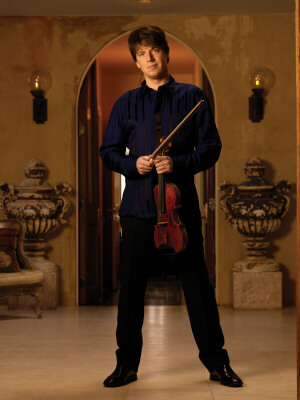Joshua Bell in superlative appearance with SF Symphony
A confluence of great conducting, brilliant playing and unusual programming made for a top-notch concert last Thursday at Davies Symphony Hall. Fabio Luisi led the S. F. Symphony in a program of Richard Strauss’ Don Juan, Franz Schmidt’s Symphony No. 4 in C major, and two of the great works for violin and orchestra performed by famed artist Joshua Bell.
Luisi, conductor of the Vienna Symphony and Dresden Staatskapelle, bounded with energy as he danced and commanded from the podium. Exacting with the violins, pleading with the cellos and demonstrative with the brass, his high energy animated an already great orchestra in a wild ride through Strauss’ tone poem of a larger-than-life degenerate.
Strauss’ brash opening tapers to a sylvan passage, with each instrument crystal clear. Violin entreats seductively, flute replies ‘yes,’ then shifts seamlessly into French horn. After flurries of brass Don Juan’s descent and death were gripping.
Joshua Bell came on-stage in what looked like boots and black silk pajamas, and if that is what it takes to coax such passion from a violin everyone ought to run out and buy a pair—although it probably wouldn’t hurt to play his 1713 Stradivarius.
Saint-Saëns’ Introduction and Rondo Capriccioso was a thrilling showcase for Bell, who tossed off crisp runs with flamboyance and a delight in his craft. His lower register had a depth which was startling, filling Davies like a much smaller hall. Rich double stops and a passage of pure down-bowing showed off Bell’s poise and mastery: no sweetly tremulous ingenue, this was high octane stuff.
The orchestra was seriously on their toes, rising to the level of the game as Luisi shifted gears
from florid to rigorous.
Bell revealed a moving gypsy temperament in Ravel’s Tzigane, another great chestnut of the violin repertoire. After a long solo, harp arpeggios ushered in the orchestra, and the piece switched from sentimental to up-tempo virtuosity.
Clarinet echoed the theme with playful runs. Bell’s left-hand pizzicato and harmonic rendition of the theme are just two of a salvo of special effects, variations in Hungarian major, leading to a mad dash to the finish.
After an intermission Luisi exposed this American audience to Schmidt’s rarely performed Symphony No. 4. Written in 1932 after the death of his daughter, it is a long letter of faith and loss. Solo trumpet stepped slowly down, a tuba mirum for our age. Strings murmured, sensitive and bright, then transformed to minor. Schmidt painstakingly built to a full-throated orchestra reminiscent of Bruckner’s Symphony No. 7 recently performed by the Berkeley Symphony. Threads of Wagner and Rachmaninov, German Romantic and Russian Romantic, weaved through the slowly shifting harmonies and lush momentum.
While not on their level, it contained moments of beauty. William Bennet performed a lovely oboe solo, and cellist Michael Grebanier soared with mid-range sonority. Timpani undertones added tension as French horn reprised the opening call, and it ended as it began, with poignant trumpet.
Schmidt, an accomplished pianist and cellist known for his nimble technique, was apparently not afraid of legato. And the middle has legato in spades. After the power of the opening movement the center felt a little heavy. While some may view this as a precursor to modern minimalism, at least one person mentioned that some deft editing–just twenty or thirty minutes–may have improved it.
—Adam Broner
Originally published in the Piedmont Post
Joshua Bell photo by Timothy White
